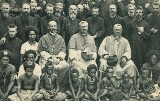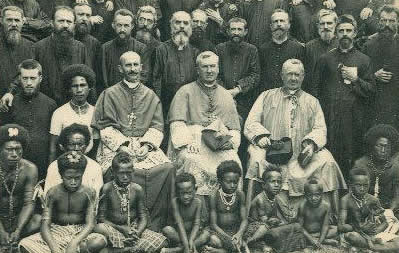
Yule Island
Encyclopedia
Yule Island is a small island
in Central Province
, Papua New Guinea
. It lies 160 km from Port Moresby
.
 Yule Island was one of the first areas in Central Province to have contact with Europe
Yule Island was one of the first areas in Central Province to have contact with Europe
ans. Catholic
missionaries
settled there in 1885 and are still present.
With the European missionaries came catechists from the Philippines
, some of which married into the local population. Today, many inhabitants of Yule Island have distinct Filipino features.
s.
Several spider
species are endemic
to this island, including:
The Early Pliocene Echinodermata fauna is rich and diverse, with 19 species known to occur in the Kairuku Formation. Nearly half of these species are also represented in northern Australia
stocks, with the northern Great Barrier Reef
only 600 km away.
. Proceedings of the Linnean Society of New South Wales 124: 125-162. (2004): The Yule Island fauna and the origin of tropical northern Australian echinoid (Echinodermata) faunas. Proceedings of the Linnean Society of New South Wales 125: 97-109. (2006): Invading Papua New Guinea, Pinoy Style
Island
An island or isle is any piece of sub-continental land that is surrounded by water. Very small islands such as emergent land features on atolls can be called islets, cays or keys. An island in a river or lake may be called an eyot , or holm...
in Central Province
Central Province (Papua New Guinea)
Central Province is a province in Papua New Guinea located on the southern coast of the country. It has a population of 183,983 people and is in size. The seat of government of Central Province, which is located within the National Capital District outside the province, is the Port Moresby suburb...
, Papua New Guinea
Papua New Guinea
Papua New Guinea , officially the Independent State of Papua New Guinea, is a country in Oceania, occupying the eastern half of the island of New Guinea and numerous offshore islands...
. It lies 160 km from Port Moresby
Port Moresby
Port Moresby , or Pot Mosbi in Tok Pisin, is the capital and largest city of Papua New Guinea . It is located on the shores of the Gulf of Papua, on the southeastern coast of the island of New Guinea, which made it a prime objective for conquest by the Imperial Japanese forces during 1942–43...
.
History

Europe
Europe is, by convention, one of the world's seven continents. Comprising the westernmost peninsula of Eurasia, Europe is generally 'divided' from Asia to its east by the watershed divides of the Ural and Caucasus Mountains, the Ural River, the Caspian and Black Seas, and the waterways connecting...
ans. Catholic
Catholicism
Catholicism is a broad term for the body of the Catholic faith, its theologies and doctrines, its liturgical, ethical, spiritual, and behavioral characteristics, as well as a religious people as a whole....
missionaries
Missionary
A missionary is a member of a religious group sent into an area to do evangelism or ministries of service, such as education, literacy, social justice, health care and economic development. The word "mission" originates from 1598 when the Jesuits sent members abroad, derived from the Latin...
settled there in 1885 and are still present.
With the European missionaries came catechists from the Philippines
Philippines
The Philippines , officially known as the Republic of the Philippines , is a country in Southeast Asia in the western Pacific Ocean. To its north across the Luzon Strait lies Taiwan. West across the South China Sea sits Vietnam...
, some of which married into the local population. Today, many inhabitants of Yule Island have distinct Filipino features.
Nature
Yule Island is surrounded by coral reefCoral reef
Coral reefs are underwater structures made from calcium carbonate secreted by corals. Coral reefs are colonies of tiny living animals found in marine waters that contain few nutrients. Most coral reefs are built from stony corals, which in turn consist of polyps that cluster in groups. The polyps...
s.
Several spider
Spider
Spiders are air-breathing arthropods that have eight legs, and chelicerae with fangs that inject venom. They are the largest order of arachnids and rank seventh in total species diversity among all other groups of organisms...
species are endemic
Endemic (ecology)
Endemism is the ecological state of being unique to a defined geographic location, such as an island, nation or other defined zone, or habitat type; organisms that are indigenous to a place are not endemic to it if they are also found elsewhere. For example, all species of lemur are endemic to the...
to this island, including:
- The jumping spiderJumping spiderThe jumping spider family contains more than 500 described genera and about 5,000 described species, making it the largest family of spiders with about 13% of all species. Jumping spiders have some of the best vision among invertebrates and use it in courtship, hunting and navigation...
species Salticus perogaster and Plexippus brachypus - Heteropoda cyanognatha and Pandercetes longipes (Sparassidae)
- Misumena arrogans and Stephanopis yulensis (Thomisidae)
The Early Pliocene Echinodermata fauna is rich and diverse, with 19 species known to occur in the Kairuku Formation. Nearly half of these species are also represented in northern Australia
Australia
Australia , officially the Commonwealth of Australia, is a country in the Southern Hemisphere comprising the mainland of the Australian continent, the island of Tasmania, and numerous smaller islands in the Indian and Pacific Oceans. It is the world's sixth-largest country by total area...
stocks, with the northern Great Barrier Reef
Great Barrier Reef
The Great Barrier Reef is the world'slargest reef system composed of over 2,900 individual reefs and 900 islands stretching for over 2,600 kilometres over an area of approximately...
only 600 km away.
Further reading
(2003): Echinoids of the Kairuku Formation (Lower Pliocene), Yule Island, Papua New Guinea: Clypeasteroida. Regularia. SpatangoidaSpatangoida
The heart urchins or Spatangoida are an order of sea urchins.Their body is a somewhat elongated oval in form, and is distinguished by the mouth being placed towards one end of the animal, and the anus towards the other. As a result, heart urchins, unlike most other sea urchins, are bilaterally...
. Proceedings of the Linnean Society of New South Wales 124: 125-162. (2004): The Yule Island fauna and the origin of tropical northern Australian echinoid (Echinodermata) faunas. Proceedings of the Linnean Society of New South Wales 125: 97-109. (2006): Invading Papua New Guinea, Pinoy Style

